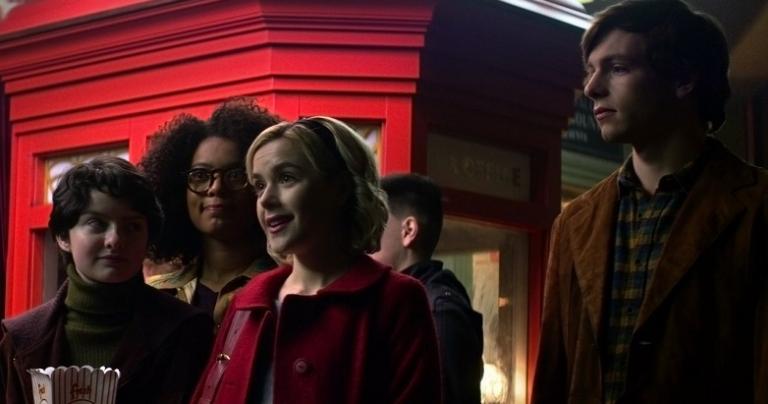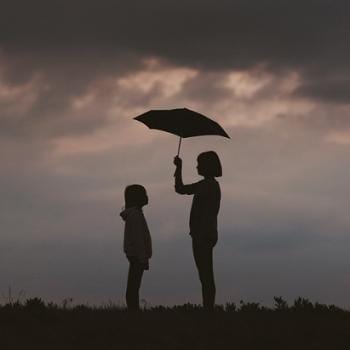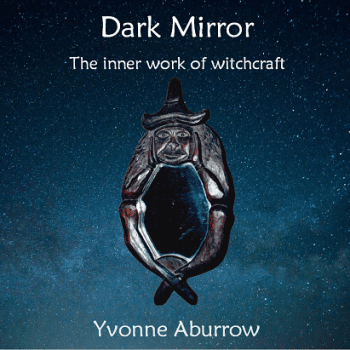[Note: I haven’t even tried to avoid spoilers in this review, because the points I have to make about the show require familiarity with multiple plot elements throughout the series, including its conclusion. Proceed with caution!]
Hello, beautiful creatures.
Last weekend, on the run-up to Halloween, my partner and I watched the entirety of Netflix’s latest original series, the much-anticipated Chilling Adventures of Sabrina. We hadn’t intended to binge it, but much like our experience with season 2 of Stranger Things last year, we looked up at one point and realized we’d just watched six episodes. (Stupid autoplay option.) Anyway, the point is, we watched the whole series in a 48-hour period, and like so much of the witchy blogosphere, I have feels about this show… but I’ll get to that in a moment.
First though, for those of you who aren’t familiar with the general concept: the series is derived from the Archie Comics Group 1970s comic book series Sabrina the Teenage Witch, which centers on the wacky hijinks of Sabrina Spellman, a teenage girl trying to balance her dual life as an ordinary high school girl and a no-foolin’, spellcasting witch. Sabrina has been previously appeared in animated form in 1970, 1999, and 2012, and as the star of a much-beloved live-action sitcom from 1996 to 2003. Rather than these cheerier versions of Sabrina, this new series is Roberto Aguirre-Sacasa’s adaptation of his 2014 comic book series Chilling Adventures of Sabrina (published by Archie Comics’ “Archie Horror” imprint), which offers a somewhat darker take on the character.
How much darker, you ask? Well, like all other versions of the character, our new Sabrina is a half-witch, half-mortal character being raised by her witchy aunts. Here, though, the aunts are members of the Church of Night, a rather ecclesiastical “coven” of theistic Satanist witches, and the central plot of the series revolves around whether or not Sabrina will sign her name in the Dark Lord’s book, surrendering her free will and becoming an agent of evil and darkness. We’re pretty far outside what many folks would expect from “Archie Comics,” in other words.
That said, the premise gives us a lot to work with, and in many ways the show goes about its work with gusto. There’s a lot here to love, and even more to inspire wry amusement, shock, and horror. Sadly, much like its titular heroine, Chilling Adventures of Sabrina is caught between two worlds, dabbling in both but fully committed to neither, and the show suffers as a result.
That’s not to say the show is bad. On the contrary, it’s extremely well made. Aguirre-Sacasa has a clear vision of what he’s doing with the show, and his diverse cast of actors, writers, and directors have all thrown in to bring that vision to macabre life. The actors tear into their roles with relish, and pretty much all of them are excellent. Kieran Shipka (of Mad Men fame) merits every bit of attention she grabs as Sabrina, deftly moving from sweet to rebellious to terrified to determined with aplomb. Also of note are Lucy Davis’ hilarious Aunt Hilda and Chance Perdomo as the delightful Ambrose Spellman, both of whom brighten every scene they steal, and Jaz Sinclair and Lachlan Watson, the actors playing Sabrina’s best friends, whose performances as Rosalind and Susie give the show a much-needed depth. (Speaking as a nonbinary person, the casting of nonbinary actor Watson as the genderqueer Susie was especially well done.)

On this level, Sabrina is just a hell of a lot of fun. Sharp-eyed viewers can make a game of spotting pop-culture references in each episode—a movie poster for Häxan here, a passing comment about tannis root there—and viewers still mourning the loss of Nineties-era Girl Power shows can cheer for the overt feminism of Sabrina‘s themes and plotlines. In many ways, Chilling Adventures of Sabrina plays a lot like a version of Buffy the Vampire Slayer with Bewitched as its inspiration, rather than vampire mythology. The trouble is, Sabrina‘s stellar performances and delightful production design aren’t enough to overcome its conceptual problems: a conflicted mythology, an ambivalence about its own definition of evil, and its deeply ambiguous approach to feminism. Any of these issues might cast a pall over the show; taken together, they punch a serious hole in its narrative and thematic coherence.
The Overly-Christian “Witches” of Greendale
Speaking frankly, Sabrina‘s worldbuilding is a hot mess. The show relies on a mythology rooted in a Manichaean anti-Christianity, presenting “witches” as devout members of an ecclesiastical Satanic church reminiscent of the worst sort of anti-Catholic tracts. (My partner and I literally laughed in disbelief at a congregation of witches chanting “And also with you!” during a church service. Apparently, these witches didn’t get the memo about the changes in the new mass.) Viewers are later treated, if that’s the right word, to the spectacle of that same witch congregation falling upon the body of a willing sacrifice, tearing it apart and eating it in a gory mockery of the Christian doctrine of transubstantiation, which the show is careful to mention by name.
At the same time, though, Sabrina‘s witches are shown doing magic which will look eerily familiar to many real-world witches: a lift from Paul Huson’s Mastering Witchcraft here, an invocation namechecking Aradia and Sybil Leek there. Knowing that the show’s production designer is apparently Pagan makes these little touches less surprising, perhaps, but it also makes the rest of the show’s depiction of witches even more perplexing. Again and again, Sabrina is careful to remind us that, by any reasonable definition of the term, they’re evil—and not just evil, but EEEEEEVIL: evil in an EC Comics sense, in a Jack Chick tract sense. These are murderers of children, blighters of crops, deceivers and liars and corrupters. They’re really, truly bad people. Moreover, as the show’s terminology contrasting “witches” and “mortals” reminds us, they’re not human. Witches live far longer than ordinary humans, have spectacular occult powers, and adhere to a morality which could be described as alien at best, and sociopathically, supernaturally evil at worst.
The Problem of Sympathetic Evil
This would all be fine if the witches were the villains in a Buffy the Vampire Slayer setting, but no, we’re asked to be sympathetic to the witches, especially as the show goes on, to precisely the degree that they conform to, or come to adopt, a human sense of morality. We’re outraged at the cruelty Aunt Zelda (Miranda Otto) inflicts on Hilda, and cheer as Hilda finds a life for herself outside the Church of Night. We wince at Zelda’s troubled relationship with an increasingly rebellious Sabrina. We sympathize with the loneliness of Ambrose’s decades-long house arrest, and cheer for his burgeoning relationship with Luke (Darren Mann). We even find some compassion for Prudence (Tati Gabrielle), the mean-girl Weird Sister whose world is wrecked by the duplicitous machinations of the authority figure she most trusts.
And then we think, Wait a minute. Aren’t these the cannibalistic Satan-worshippers? Aren’t they literally evil?
The tension of sympathizing with evil characters, or at least morally dubious characters, can be employed to great effect, as Breaking Bad and Mad Men have shown. To make that work, though, the show itself must exist within a moral universe of some sort; while the show might ask us to root for morally flawed characters, on some level it acknowledges that what those characters doing is evil, that they shouldn’t succeed. In Sabrina, however, the evil of the characters is portrayed as morally neutral, cartoonishly melodramatic, and over-the-top… except when it’s not, when it has real-world effects which destroy lives and traumatize the people it doesn’t kill. This dichotomy is never addressed within the show’s own moral universe. Our characters are shown to be far more morally ambivalent than our first impressions would indicate, as we see them having misgivings about their own actions and about the culture in which they’re enmeshed. This would be an excellent narrative direction to take, if the show were committing to an arc of redemption… but it isn’t, at least as of the end of Season 1 (about which more in a moment).
In short, Sabrina wants to have it both ways: it wants its preternaturally evil characters to be truly evil and amoral, but also sympathetic and worthy of sympathy.
The Ambivalent Feminism of Sabrina
The other major issue I had with Sabrina is its curiously uncomfortable relationship with feminism. On the surface, few genre shows have embraced feminist themes as overtly and enthusiastically as Sabrina, and many feminist viewers have responded in kind. Sabrina positions herself as a young woman stepping into her own power and agency throughout the series, empowering herself and lifting up her sisters and nonbinary siblings in the process. She helps to organize a feminist club at her high school, the slyly-named “Women’s Intersectional Cultural and Creative Association,” or WICCA. She has an adorable, overtly consent-based relationship with her boyfriend, the endearingly sweet Harvey Kinkel (Ross Lynch). She finds herself at odds with the high school principal (Bronson Pinchot), a misogynist of the first order. She proceeds to her Dark Baptism only after reassurance from Father Blackwood (Richard Coyle, in finest Hammer horror style), the head Satanic priest, that signing The Book of the Beast offers her freedom of choice, liberation from patriarchal shackles.
Of course, this all gets complicated in short order, as Sabrina and the viewers learn that the “freedom” offered by signing the Dark Lord’s book turns out to be eternal service to the powers of evil. The balance of the series revolves around Sabrina’s struggle to reconcile her human and witch natures, to find a way of living in both worlds without surrendering her free will to Satan or losing her magical powers to the mundane world. This is further complicated by the efforts of almost every witch in her life—including her confidant, Ms. Wardwell (Michelle Gomez), who turns out to be far more than she appears—to force, coerce, trick, or in some other way convince Sabrina to sign the book. Sabrina spends nine-tenths of the series in this middle ground between the mortal and witch worlds, looking for a way to eat her cake and have it too, before [SPOILER WARNING!] giving in and signing the book in the final episode, selling her soul to Satan in exchange for the power to dispel the evil threat besieging her town. In the show’s final shots, we are shown Sabrina, dressed to the nines and sporting a smokin’ Expository Hairstyle Change, marching in lockstep with the Weird Sisters, tipping a saucy wink at bad-boy heartthrob Nick Scratch (Gavin Leatherwood), leaving viewers with the unmistakable impression that she’s become a Weird Sister, a Mean Girl, an avowed Satanic witch. Sabrina hasn’t just gone over to the dark side, she’s pole-vaulted into it.
So much for free will and feminism, right?
What galls me here is how this is portrayed in the show as a choice, when the reality is that Sabrina never had more than the illusion of choice. Sure, she could’ve chosen not sign her name, to keep her soul and her autonomy. That choice would have allowed the Red Angel of Death and the Thirteen Witches to murder every firstborn child (and adult) in the town, though, so in the moral universe of the show, either choice was a non-choice. It’s suggested in the finale that all the machinations of this season were merely to set up Sabrina to be Satan’s bride, presumably as a means of bringing about the end of the world. As such, the ultimate message of the series to date would seem to be, “Sure, feminism might feel empowering and all, but sooner or later you’re gonna have to give in and accept your fate as the concubine of a powerful man, who will own you eternally.”
That’s not feminism, dear ones. That’s the opposite of feminism.
To Be Continued…
Now, I’m willing to admit that my take on this could be wrong. Part of the problem is that, like everyone else, I’m working with incomplete information. After all, as Netflix is careful to point out, this is only Part 1 of the series. The finale of Part 1 is clearly a cliffhanger ending, and Part 2 of Sabrina is already in production. I’m hoping against hope that the next season will get the series out of the sticky thematic corners into which the show has painted itself because, as tiresome as I found the show’s Rosemary’s Baby-esque gothic trappings, there’s some real potential here as well, and on balance I enjoyed more than I found disappointing.
That disappointment is real, though, and dispelling it will require more than a reversing candle and a lavender-and-tannis-root smoothie.
Until next time, dear ones, keep yourselves safe. ♥
https://youtu.be/eZ9IdzzO3Z4

















